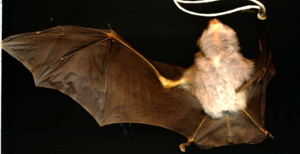Blaise horseshoe bat
| Blaise horseshoe bat | ||||||||||||
|---|---|---|---|---|---|---|---|---|---|---|---|---|

Blaise's horseshoe bat, prepared specimen |
||||||||||||
| Systematics | ||||||||||||
|
||||||||||||
| Scientific name | ||||||||||||
| Rhinolophus blasii | ||||||||||||
| Peters , 1866 |
The Blasius horseshoe bat ( Rhinolophus blasii ) is a bat belonging to the horseshoe bat family .
It is a medium-sized bat and corresponds in size to the Mediterranean horseshoe bat ( Rhinolophus euryale ) and the Meheley horseshoe bat ( Rhinolophus mehelyi ). The IUCN classifies the Blasius horseshoe bat as "potentially endangered" (near threatened) .
features
The head body length of the Blasius horseshoe bat is 45 to 55 mm, the tail length 25 to 30 mm and its wingspan is 27 (22) to 31 cm. It weighs on average between 12 and 16.5 g. The fur is loose, the top is gray-brown, often with a lavender tone, the hairlines and the underside are almost white. Around her eyes she has at most a hint of “glasses”. It differs from the Mediterranean horseshoe bat and the Meheley horseshoe bat primarily in the shape of the nasal growths and the length of the fingers.
Distribution, habitat and way of life
The Blasius horseshoe bat is only common in Europe in the eastern Mediterranean, its distribution area extends from Turkey via the Balkans to western Italy , Sicily and Malta. They can also be found in the Middle East and on the North African coast and in other parts of Africa. She inhabits karst areas with shrubs and trees.
The summer quarters with up to 300 females and the winter quarters with up to 3000 animals are almost always in caves and hardly ever inside buildings. The Blasius's horseshoe bat often shares her habitation with other bats, including the Mediterranean horseshoe bat , greater horseshoe bat , Geoffroy's bat , greater mouse-eared , Little Mouse-eared , Schreiber's bat and long-fingered bat .
protection
The Blasius horseshoe bat is listed by the European Union in Annexes II and IV of the Habitats Directive and is therefore a species of community interest that must be strictly protected, and special protected areas must be designated for their preservation.
literature
- Wilfried Schober, Eckhard Grimmberger: The bats of Europe - know, determine, protect. 2nd updated edition, Franckh-Kosmos , Stuttgart 1998, ISBN 3-440-07597-4 .
Individual evidence
- ↑ a b Klaus Richarz. Observe, recognize and protect bats. Franckh-Kosmos , Stuttgart 2004 ISBN 978-3-440-09691-8 p. 103
